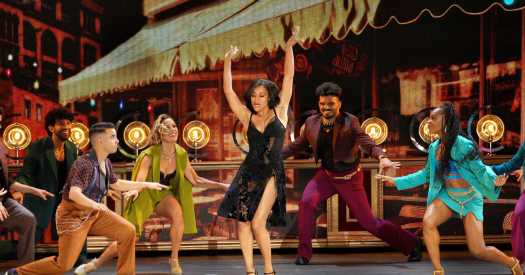The CBS telecast of the Tony Awards drew 4.3 million viewers on Sunday night, the second consecutive year that the broadcast has seen a bump in the ratings, according to Nielsen.
The modest increase in viewership at a moment where people are fleeing broadcast television qualifies as a win these days. And the fact that the Tonys gained audience share is part of a trend where award shows have stopped the bleeding after years of steep losses. This year’s Oscars and Grammy Awards both increased their viewership, too.
Still, for the Tonys, which is a relatively niche ceremony compared to more popular awards shows, Sunday’s ratings represent the third-lowest viewership total since records have been kept. Last year’s ceremony drew 3.9 million viewers.
The fact that the Tonys happened at all took no small effort. Just a month ago, the televised ceremony was in jeopardy after the union representing thousands of striking movie and television writers — who have been on strike against the major Hollywood studios since May 2, arguing that their wages have stagnated despite the streaming production boom — threatened to picket the event.
The writers have deployed aggressive tactics to hurt the studios during the strike, and a live event broadcast on CBS was lining up to be a good target. (The writers had already successfully disrupted the MTV Movie & TV Awards last month, which prompted the cancellation of the live ceremony; MTV and CBS share the same corporate parent, Paramount.)
But a group of playwrights lobbied leaders of the Writers Guild of America, the union representing the writers, arguing that the cancellation of the event would hurt the theater industry more than it would hurt CBS. The Tony Awards represent a vital marketing tool for Broadway as it still makes its slow recovery out of the pandemic. Given the relatively low viewership of the Tonys, the show has always been more of a prestige play for CBS than a profit machine.
The W.G.A. relented, and the end result was an awards show that went heavy on live performances and introductory videos, and went without scripted material or pre-written bits. Presenters did little more than introduce themselves and announce the nominees and winners. The striking writers were given repeated shout-outs throughout the night.
W.G.A. leaders expressed approval on Monday morning, with the union’s Eastern branch tweeting, “A big congratulations, and a big thank you to the Tony Award winners who stood with the #WGAstrike in their speeches. Thank you to attendees wearing #WGAstrong pins, and to everyone who showed solidarity with the writers during last night’s unscripted awards show.”
The unscripted ceremony, which was hosted by Ariana DeBose, was mostly well received. Jesse Green, The New York Times’s theater critic, observed, “Previous Tonys telecasts have often wasted their ‘bumpers’ — the gaps between the end of a big performance or award and the commercials that follow — with unconvincing scripted nonsense. Guess what? No script, no nonsense.”
In 2021, the Tony Awards drew a record low of 2.8 million viewers when the pandemic-altered ceremony aired in September, three months later than its traditional mid-June slot. The highest-rated Tony Awards in recent years was in 2016, when a “Hamilton”-fueled ceremony had an audience of 8.7 million viewers.
The top-rated markets for Sunday’s telecast were, in order, New York, West Palm Beach, Fla., and San Francisco, according to Nielsen.
John Koblin covers the television industry. He is the co-author of “It’s Not TV: The Spectacular Rise, Revolution, and Future of HBO.” @koblin
Source: Read Full Article
